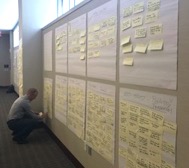
By Mandy Long, Chair of the EHRA Clinician Experience Workgroup, and Vice President of Corporate Operations at Modernizing Medicine
On June 21, 2017, I had the pleasure of co-hosting EHRA’s Shaping Usability of Health IT Summit in Washington, DC. We had an impressive turnout, with over 70 attendees from across the health technology spectrum – from ONC’s Deputy Assistant Secretary for Health Technology Reform Dr. John Fleming and other government officials, to physicians and nurses, to user-centered design experts, to EHR developers.
The engaging conversations highlighted the passion of those in attendance and addressed some of the most challenging issues facing the industry today. Facilitated discussions with influential stakeholders in a cross-functional forum to achieve specific usability-related goals was a novel approach for this type of gathering and good first step to problem-solving.
Across the health IT continuum, we see executives and frontline clinicians experiencing real joys, as well as real frustrations, in using technology in their daily working lives. On an almost daily basis, we all engage to create solutions for the challenges that we face as an industry. You know the buzz words – terms like “physician burnout” and “administrative burden.” As technology leaders, we spend a lot of time speaking to our end-users about what it takes to continually improve and move forward. Usability is at the forefront of our discussions.

Participants in the hands-on Usability Summit created detailed “personas” for a variety of types of EHR users.
We had two main goals for the 2017 Usability Summit:
- Kicking off the EHRA’s Personas Project, a first in the industry
- Unveiling our latest achievement, EHRA’s Design Patterns for Safety, a project that was started as an outcome of our first cross-stakeholder usability summit in December 2015
Kath Straub, PhD, provided the event’s keynote. As the Principal of Usability.org, Kath applies the psychology of behavior to help clients better understand, motivate, and communicate with customers. Her message was clear: the key to our success as an industry is rooted in our ability to listen, to have the tough conversations, and to remember that we aren’t designing or implementing software for ourselves. We’re creating and deploying it for the patients and end-users who interact with our EHRs and other health IT every day.

For a hospital IT staff member, participants focused on what that persona’s goals and motivations may be.
Facilitators led attendees through a series of hands-on exercises in order to kick off the Personas Project, geared towards creating an industry personas repository to serve as a common set of reference definitions when considering user perspectives in the design, deployment, and optimization of EHRs. This repository will also function as a reference in future iterations of the Design Patterns for Safety.
In the art and science of user-centered design, a persona is an idealized representation of a core user group, incorporating that group’s goals, their needs, and their values and interests. Understanding who is using EHRs and their true needs, in a validated format, is key to designing usable software because it provides a basis for making decisions that reinforce user goals. Best practices in design thinking and user-centered design are built on defining your user(s); these are used across many industries.
The working groups at the summit drafted 10 user personas, ranging from a Medical Assistant to a Primary Care Physician to a Hospital IT Technician to a Chronically Ill Patient. We also discussed how each persona has had their needs met (or not) by existing EHRs. In a complex system such as healthcare, it’s important to recognize that optimizing for a small set of users can cause other users to have an unacceptable experience.

Participants in this group named their persona, a chronically ill patient, “Fred,” and considered what his goals may be, from exercising more to learning about new treatment options.
The output of this effort was, as quoted by several attendees, a “groundbreaking” collection of data. The EHRA Clinician Experience Workgroup is now compiling this data into a draft that will be published for comment as the first iteration of the Personas Project. To our knowledge, a collaborative, shared repository like this has never been attempted before in our industry, maybe because it isn’t easy! And the benefits extend beyond EHRA members, as anyone involved in HIT can leverage the personas made available.
The creation of a personas repository could ensure that we work from common foundations when designing solutions; it could function as a catalyst for our industry and its participants to prioritize who we are going to focus on first, and what their most urgent needs are. I am certainly optimistic, and I hope you’ll join us on the journey by providing feedback on our work and reaching out if your organization is working on initiatives that would benefit from our collaboration.
To learn more about the EHR Association, visit www.ehra.org.
I’d like to extend a special thank you to my co-hosts, Janet Campbell (Epic) and Ross Teague (Allscripts), as well as to our incredible facilitators: Ann Ou (Practice Fusion), Andrew Seymour (NextGen Healthcare), Andrew Schall (Modernizing Medicine), Diya Deb (GE Healthcare Digital), Chris Pokrzywa (Epic), Busra Demirci (Modernizing Medicine), Kathryn Summers, MD (University of Baltimore), and Steven Jones, MD (MEDITECH).

5 Comments